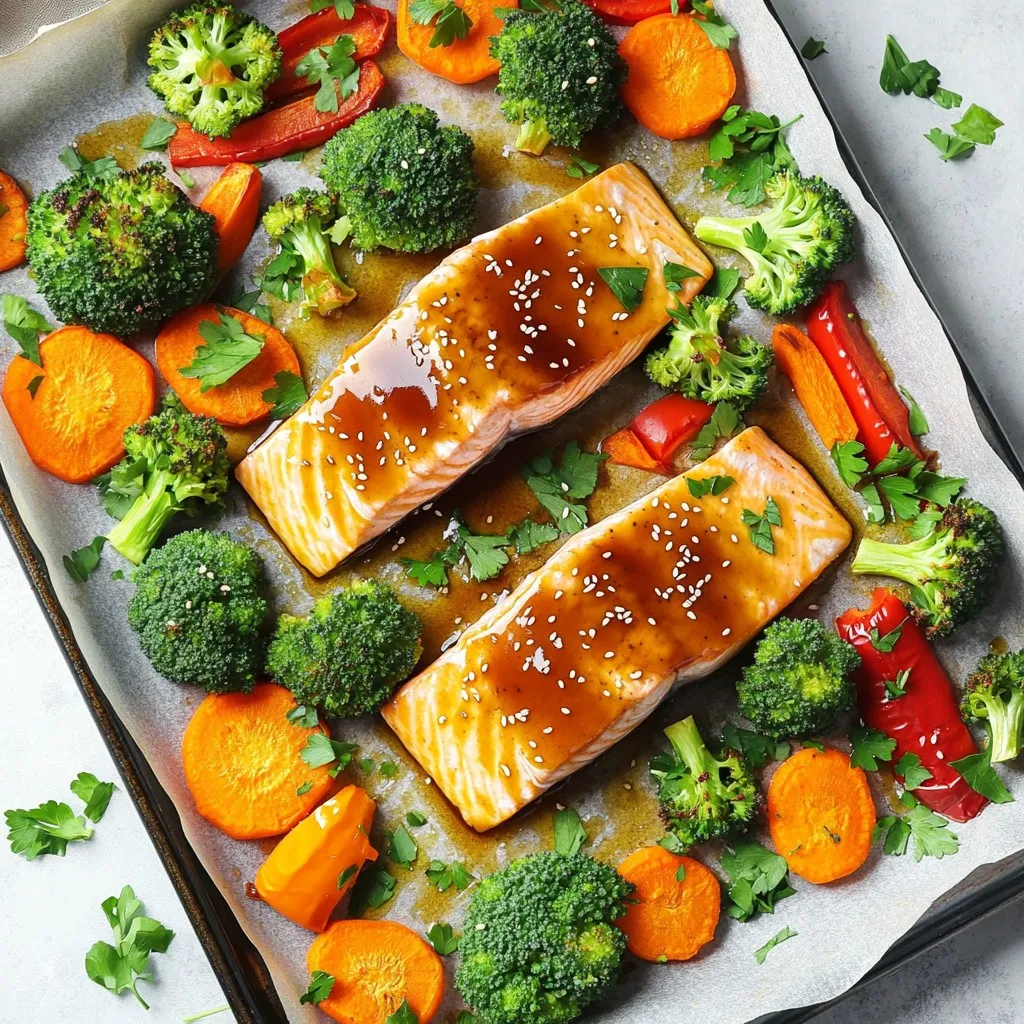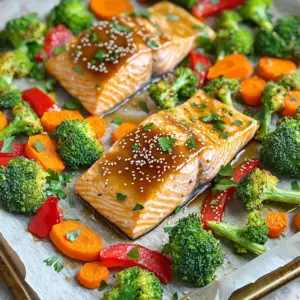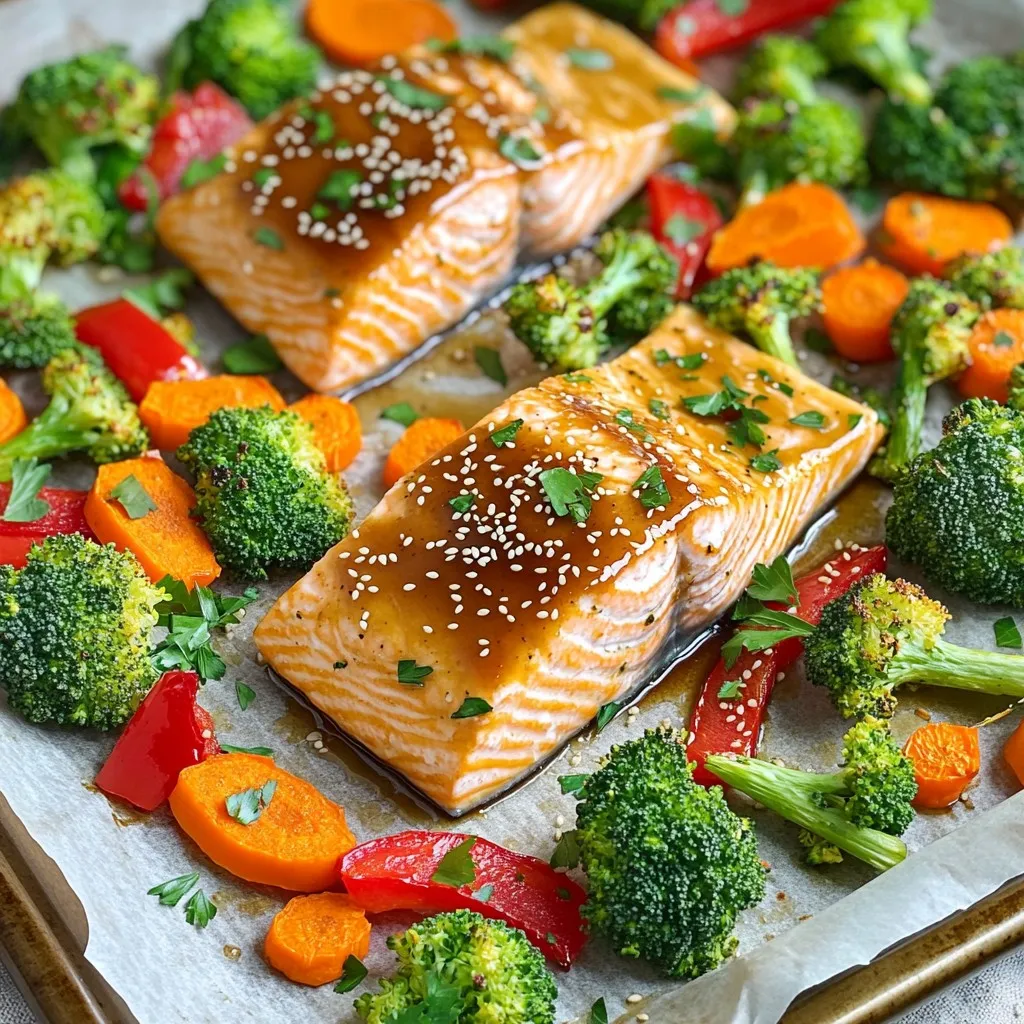Looking for a delicious, easy dinner option? My Sheet Pan Maple Dijon Salmon & Veggies Delight is just the answer! This dish combines tender salmon fillets, fresh veggies, and a sweet-savory glaze that will impress everyone at your table. Plus, it’s all made on one pan, making cleanup a breeze. Let’s dive into this simple recipe that packs a flavor punch and keeps dinner stress-free!
Ingredients
Main Ingredients
– 4 salmon fillets
– 2 tablespoons Dijon mustard
– 3 tablespoons pure maple syrup
Vegetable Ingredients
– 1 cup broccoli florets
– 1 cup baby carrots, cut in half lengthwise
– 1 red bell pepper, sliced into strips
Seasoning and Garnish
– 1 tablespoon olive oil (plus extra for veggies)
– 1 teaspoon garlic powder
– 1 teaspoon onion powder
– Salt and pepper to taste
– 1 tablespoon sesame seeds (for garnish)
– Fresh parsley, chopped (for garnish)
Gathering fresh ingredients sets the stage for a tasty meal. Salmon fillets are the star of this dish. They are rich in omega-3 fats and full of flavor. Dijon mustard adds a tangy kick. Pure maple syrup gives a sweet balance. The mix creates a glaze that shines on the salmon.
For veggies, I love using broccoli florets. They add crunch and color. Baby carrots bring a nice sweetness, especially when roasted. Red bell pepper adds bright flavor and pairs well with salmon. Together, these vegetables make a colorful, nutritious plate.
Seasonings are key for flavor. Olive oil helps the veggies roast well. Garlic powder and onion powder add depth. Salt and pepper enhance all the tastes. Sesame seeds and fresh parsley finish the dish with texture and freshness.
With these ingredients, you’re ready to create a delightful meal.
Step-by-Step Instructions
Preparing the Oven and Baking Sheet
1. First, preheat your oven to 400°F (200°C). This heat is key for cooking the salmon and veggies just right.
2. Next, line a large baking sheet with parchment paper. This helps with easy cleanup and prevents sticking.
Making the Maple Dijon Glaze
1. In a small bowl, whisk together the Dijon mustard, pure maple syrup, and olive oil.
2. Add garlic powder, onion powder, and a pinch of salt and pepper.
3. Keep whisking until the mixture is smooth and well blended. This glaze adds a sweet and tangy flavor that makes the dish shine.
Arranging the Salmon and Veggies
1. Now, place the salmon fillets on one side of the baking sheet.
2. Generously brush the maple Dijon mixture over each salmon fillet. Make sure each piece is well coated for maximum flavor.
3. In another bowl, combine the broccoli florets, halved baby carrots, and red bell pepper strips.
4. Drizzle a little olive oil over the veggies. Season with salt and pepper, then toss to coat evenly.
Roasting Everything Together
1. Spread the seasoned vegetables on the empty side of the baking sheet. Keep them in a single layer for even roasting.
2. Slide the baking sheet into the preheated oven. Roast for about 15 to 20 minutes.
3. The salmon is ready when it flakes easily with a fork, and the veggies are tender yet slightly crisp.
4. Once done, remove the baking sheet and sprinkle sesame seeds and fresh parsley over the dish for a lovely finish. Enjoy the bright colors and great flavors!
Tips & Tricks
Tips for Perfectly Cooked Salmon
– Checking for doneness: To know when your salmon is ready, look for a change in color. The salmon should turn from bright pink to a lighter, opaque shade. You can also check if it is firm to the touch. If it feels soft, it needs more time.
– Flaking with a fork: Once you think the salmon is done, take a fork and gently press down on it. If it flakes easily, it is ready to eat. This method works best to ensure the fish is perfectly cooked.
Vegetable Cooking Tips
– Achieving uniform roasting: To get your veggies just right, cut them into similar sizes. This helps them cook evenly. Spread them out in a single layer on the baking sheet, so they do not steam.
– Best veggie pairings: Broccoli, carrots, and red bell peppers are excellent choices. You can also try zucchini, asparagus, or green beans. Each adds a unique taste and color to your dish.
Glaze Adjustments
– Making it spicier or sweeter: If you like a kick, add a pinch of cayenne pepper or a dash of hot sauce to the glaze. For more sweetness, you can increase the maple syrup. Just mix it in until you reach your desired flavor.

Variations
Alternative Proteins
You can swap salmon for chicken or tofu. Chicken thighs are juicy and cook well. Use boneless skinless chicken breasts for a leaner option. For a plant-based choice, firm tofu works nicely. Press the tofu to remove excess water. Then cut it into cubes and coat with the glaze just like the salmon. Bake as you would the salmon, adjusting time as needed.
Veggie Substitutions
Feel free to switch up the vegetables. Asparagus, zucchini, and green beans also roast well. You can use cauliflower florets for a hearty bite. Sweet potatoes add a nice sweetness and texture. Just remember to cut them into small pieces for even cooking.
Flavor Variations
Get creative with your glaze! You can try other mustards, like whole grain or spicy brown mustard. Honey or agave syrup can replace maple syrup for a different sweetness. You might even add a splash of soy sauce for a savory twist. A pinch of chili flakes can add heat if you like spice.
Storage Info
Storing Leftovers
To keep your leftovers fresh, use airtight containers. Glass or plastic containers work great. Make sure to let the food cool first. This way, it won’t steam and get soggy. Store your leftovers in the fridge for up to three days.
Reheating Instructions
For the best taste, reheat your salmon and veggies in the oven. Preheat the oven to 350°F (175°C). Place the leftovers on a baking sheet. Heat for about 10-15 minutes or until warm. You can also use a microwave. If you do, cover the dish with a microwave-safe lid to keep it moist.
Freezing Guidelines
You can freeze the salmon and veggies. Place them in a freezer-safe bag. Remove as much air as possible. This helps prevent freezer burn. Your meal will stay good for up to three months. To eat, thaw it overnight in the fridge before reheating.
FAQs
Can I use frozen salmon?
Yes, you can use frozen salmon. Thaw it first for best results. To thaw, place the salmon in the fridge overnight. If you’re short on time, use a sealed bag and submerge it in cold water for about an hour. Once thawed, pat it dry with a paper towel before cooking. This step helps the glaze stick better.
What sides pair well with this dish?
This dish goes well with many sides. Try serving it with:
– Quinoa or rice
– Mashed potatoes
– A fresh green salad
– Garlic bread
These sides will complement the salmon and veggies nicely.
How do I know when the salmon is fully cooked?
You can tell the salmon is done when it flakes easily with a fork. The color should change from a bright pink to an opaque shade. If you have a meat thermometer, the inside temperature should reach 145°F (63°C).
Can I prepare the glaze in advance?
Yes, you can prepare the glaze ahead of time. Mix all the glaze ingredients and store it in an airtight container. Keep it in the fridge for up to three days. When you are ready to cook, just give it a good stir before using it. This makes meal prep quick and easy!
This dish combines simple, fresh ingredients for a tasty meal. You learned about selecting salmon, easy veggies, and a great glaze. Following the steps ensures your meal turns out perfect every time. Don’t forget the tips and tricks to adjust flavors and check for doneness. Storing leftovers or trying variations keeps your meals exciting. Enjoy cooking and experimenting with this delightful recipe! You’ll impress family and friends with your delicious creations.

